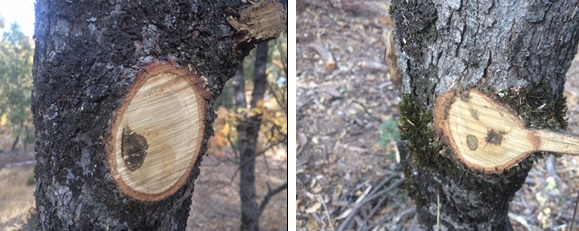Mariposa Native Plants: Oak Tree Maintenance For the Sierra Foothills
Introduction
Native oak trees grow throughout California, with the exception of the dryer areas of the southeast
deserts. They are long-lived, adaptable, and valuable plants in the landscape and around the home.
Oaks are also surprisingly easy to care for and maintain, as long as you do not make certain basic
mistakes. This page concentrates on maintaining the oak trees found in Mariposa and surrounding
counties. Shrub oaks are not discussed.

(Fig. 1) A young Black Oak (Quercus kelloggii) in the early fall (above).
Basic Oak Tree Management
The overriding concern in oak tree care is protecting the ground around the tree. The drip zone is
the roughly circular area underneath the tree’s leaves. But, a mature oak tree sends out shallow roots well
beyond the drip zone. Thus, you should avoid disturbing the ground within what is called the Critical Root
Zone (CRZ) around the tree, the circular area with a radius at least 1/3 larger than the drip zone. Oak
tree rooting habits play a role in this concern. Upon germination from an acorn, oak tree sprouts send down
a deep tap root, endeavoring to contact a reliable water source. Thereafter, the tree sends out shallow
surface roots which extend beyond the tree’s dripline; oaks are distinguished in this way. They are also
particularly sensitive to disturbance in this shallow surface root zone, the CRZ (Fig. 2).
Thus, basic oak tree management steps pertaining to the root zone are the following:
- The 6 foot rule: Do not disturb the ground within six feet of the trunk of the tree.
- Avoid disturbance in the CRZ.

(Fig. 2) It is OK to have a few low-water native California plants in the CRZ, but 6 feet from the trunk.
- Do not adjust the grade around an oak tree. Do not add soil fill that covers the CRZ. Do not scrape away
surface soil from beneath the oak tree within the CRZ.
- Do not drive vehicles over the CRZ; this compacts the surface soil and harms the sensitive surface roots of the oak tree.
- Avoid adjacent structures that trap water, such as retaining walls.
- Allow only minimal water native plants outside of the 6 foot rule zone.
- Generally speaking, do not water oak trees in the summer. Warm ground temperatures and high soil moisture
promote the growth of fungi that can kill an oak tree.
Oak trees are also sensitive to pruning. The best practice is to minimize pruning on mature oak trees. The basic principles
for pruning California native oak trees are the following:
- Prune dead and dying branches as needed.
- In the case of large branches that present a hazard or are likely to cause structural failure of the tree, try to reduce
the leveraging weight on the branch by removing outer lateral branches that are an inch or two in diameter.
- To prune large branches, use the three step pruning cut. Begin about 1 foot from the trunk of the tree and saw
upward from the bottom of the branch about 1/3 of the way through. Next, a couple of inches beyond the first cut, but now
from the top of the branch, cut through the branch to drop it. Finally, remove the remaining stub by cutting it off just
outside the branch collar (Fig. 3), the ring of rippled bark that surrounds a branch when it attaches to the tree trunk. Try to cut
perpendicular to the centerline of the branch.

(Fig. 3) On the left is a good cut just outside the branch collar. Over time this cut will heal over almost completely.
The cut on the right, however, intrudes into the main bark of the tree trunk on the left, and it leaves a partial branch stub on
the right; it's technically poor on both counts. This cut probably won't heal very well, but it's not bad enough to seriously
affect the overall health of the tree.
You should take into account the species and the age of an oak tree when contemplating pruning work.
- Prune deciduous oaks (Blue, Black, Valley, and Oregon) when they are dormant (winter).
- Prune evergreen oaks (Interior and Canyon Live) in the mid-summer (July-August) if necessary, but try to delay pruning until
the fall or winter.
- Prune young oaks near structures and passageways so that they grow with a dominant central leader and exhibit well-spaced
scaffold branches; young oak trees on the distant landscape can be safely left alone.
Our plant list on Calscape's webpage:



